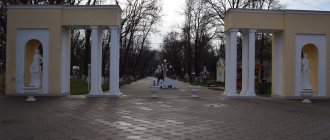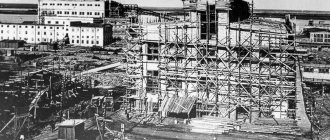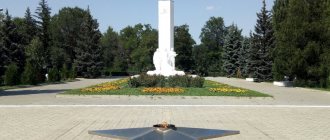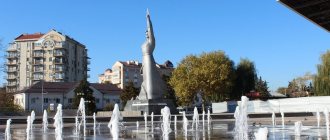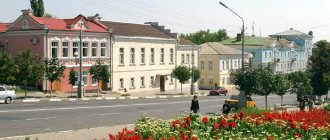City in Kaluga region, Russia
| Mosalsk Mosalsk | |
| Town[1] | |
| Coat of arms | |
| Location of Mosalsk | |
| Mosalsk Location of Mosalsk Show map of Russia Mosalsk Mosalsk (Kaluga region) Show map of Kaluga region | |
| Coordinates: 54°30′N 34°59'E / 54.500°N Latitude 34.983°E / 54.500; 34.983Coordinates: 54°30′N 34°59'E / 54.500°N. Latitude 34.983°E / 54.500; 34.983 | |
| A country | Russia |
| Federal subject | Kaluga region[1] |
| Administrative region | Mosalsky district[1] |
| First mention | 1231 |
| City status from | 1776 |
| Height | 210 m (690 ft) |
| population (2010 Census)[2] | |
| • General | 4,288 |
| • Evaluate (2018)[3] | 4,202 (−2%) |
| Administrative status | |
| • Capital from | Mosalsky district[1] |
| Municipal status | |
| • Municipal district | Mosalsky municipal district[4] |
| • Urban village | Urban settlement Mosalsk[4] |
| • Capital from | Mosalsky municipal district[4], urban-type settlement Mosalsk[4] |
| Timezone | UTC + 3 (MSK [5]) |
| Postal code(s)[6] | 249930 |
| Dial code(s) | +7 48452 |
| OKTMO I WOULD | 29629101001 |
Mosalsk
(Russian: Mosalsk) is a town and the administrative center of Mosalsky District in Kaluga Oblast, Russia, located 82 kilometers (51 mi) west of Kaluga, the administrative center of the region. Population: 4,288 (2010 Census);[2]4,380 (2002 Census);[7]4,610 (1989 Census).[8]
Story
Historical affiliation
Grand Duchy of Lithuania 1407–1493 Grand Duchy of Moscow 1493–1547 Kingdom of Russia 1547–1721 Russian Empire 1721–1917 Russian Republic 1917 Soviet Russia 1917–1922 Soviet Union 1922–1991 Russian Federation 1991–present
First attested in 1231 as Masalsk
(Masalsk), it became the center of one of the Verkhneoka principalities in the 14th century. [
citation needed
] After Ivan III annexed the principality to the Grand Duchy of Moscow in 1493, local princes emigrated either to the Grand Duchy of Lithuania (where they became known as the Princes of Massalsk) or to Moscow (where they were known as the Koltsov-Mosalsky princes). Mosalsk was given the status of a city in the Kaluga province in 1776.
The city of Mosalsk is the administrative center of the Mosalsky district of the Kaluga region. Located in the west of the Kaluga region, 18 km from the Moscow-Roslavl highway ( A101 ). The distance to Moscow is 255 km, to Kaluga – 93 km. The nearest railway station Baryatinskaya is located at a distance of 33 km.
The population in 2010 was 3,900 people.
In the first third of the 13th century, Novgorod troops led by Prince Yaroslav Vsevolodovich and his relatives, the princes of Belozersky and Yaroslavl, invaded the Chernigov principality from the northeast. This is where the city of Mosalsk is mentioned for the first time. It was in 1231, apparently at the end of summer or beginning of autumn. Approaching Mosalsk , Yaroslav besieged it. However, he did not take it and retreated with nothing.
Borderland is a distinctive feature of the situation of the Mosal lands. The guard fortress on the northeastern outskirts of the Chernigov lands over time became an outpost of the Moscow state on the border with Lithuania or Lithuania on the border with Muscovy, and changed hands several times.
Only after liberation from the Tatar-Mongol yoke (1480) did the Moscow state decisively take up the return of the lands seized by Lithuania. In 1490, the princes of Vorotyn and Przemysl joined Moscow with their appanages. In 1492-1493 They, with the support of the Odoevsky princes, captured the cities of Mosalsk , Serpeisk and Meshchovsk, which surrendered without a fight. In 1494, the war ended with the signing of a peace treaty, according to which Kozelsk, Serensk, Vorotynsk, Przemysl, Meshchovsk, Belev and Odoev remained with Moscow, and Serpeisk and Mosalsk with Lithuania.
Having become part of the centralized Moscow state, Mosalsk served as a border fortress for another hundred years, defending the southwestern borders from the raids of the Crimean Tatars and Nogais, who repeatedly - in 1584, 1587, 1592, 1595 and 1597. - devastated the surroundings of Mosalsk , Belev, Kozelsk, Przemysl, Meshchovsk and Vorotynsk.
Under 1660, Mosalsk is mentioned as a military garrison with 229 archers, gunners and other soldiers, surrounded by rotten spruce fortress walls with two blind towers. With this news, the history of Mosalsk as a border fortified city ends. But the military history of the city does not end.
The decisive events of the Patriotic War of 1812 took place on the territory of the Kaluga province. The defeat of Napoleonic army began here. Military operations did not directly affect the Verkhovsk cities, but their residents took an active part in partisan warfare and supplying supplies to the Russian army. Thus, partisan detachments in Mosalsky district alone killed and drowned 987 Frenchmen and captured 450.
After the end of the Patriotic War, Meshchovsk, Mosalsk and Serpeisk developed as local trade, craft and administrative centers. The main transit routes - the Warsaw and Kiev highways, although they passed through the territory of the counties, but bypassed their centers, as a result of which the industrial and commercial potential of the cities, without having time to receive proper development, sank into oblivion. The construction of the Kyiv Railway in 1896 only aggravated the disadvantage of their economic and geographical position.
At the very end of February 1917, the tsarist autocracy, hated by the people, collapsed. About this second bourgeois-democratic revolution - the February - local historical facts are usually given little. Meanwhile, they were, and quite significant.
In Mosalsk, the new government established itself quickly and without much resistance. Everyone was waiting for a change in the incompetent policy, complicated by the imperialist war imposed by the bourgeoisie.
On October 3, 1941, Nazi troops occupied Meshchovsk and captured Mosalsk . But already in December 1941, as a result of the counter-offensive of the Red Army near Moscow, the armies of the Western Front began to liberate Kaluga land. On January 3, 1942, the operation to liberate Meshchovsk began, which was successfully completed by noon on January 7; another day later, Red Army units entered Mosalsk.
In 1980-1990, new microdistricts were built in the city.
Today Mosalsk is a typical small town of the Non-Black Earth Region, a node of an agricultural region, combining the functions of an administrative center and a center for servicing agricultural production. The critical situation that developed in the agriculture of the Non-Black Earth Zone was not slow to affect the appearance of both the city and nearby rural settlements, and the way of life of the population.
Mosalsk is an ancient city that has preserved several architectural monuments: St. Nicholas Cathedral , 1818 - a good example of classicism (recreated “from the foundation”). Trinity Church 1745 Pyatnitskaya Church 1765 - once a five-domed (now the chapters are lost) temple, impressively rising on a hill in the form of picturesque ruins - Boris and Gleb Church (1791), interesting paintings in the interior.
Phone code: +7 48452 City forum: www.mosalsk.info City website: www.mosalsk.h12.ru
Recommendations
Notes
- ^ a b c d f
State Committee of the Russian Federation on Statistics.
Committee of the Russian Federation for Standardization, Metrology and Certification. No. OK 019-95 January 1, 1997 “All-Russian classifier of objects of administrative-territorial division. Code 29 229”, Ed. changes No. 278 / 2015 dated January 1, 2016. (State Committee of the Russian Federation on Statistics. Committee of the Russian Federation on Standardization, Metrology and Certification. No. OK 019-95 January 1, 1997 Russian Classification of Administrative Objects (OKATO). Code 29 229
As amended by Amendment No. 278/2015 dated January 1, 2016). - ^ a b
Federal State Statistics Service of Russia (2011).
“All-Russian Population Census 2010. Volume 1" [All-Russian Population Census 2010, vol. 1]. All-Russian Population Census 2010 [All-Russian Population Census 2010]
(in Russian). Federal State Statistics Service. - "26. The size of the permanent population of the Russian Federation by municipalities as of January 1, 2022.” Federal State Statistics Service. Retrieved January 23, 2022.
- ^ a b c d e
Law No. 7-OZ - "On the calculation of time." Official Internet portal of legal information
(in Russian). June 3, 2011. Retrieved January 19, 2022. - Post office. Information and computing center of OASU RPO. ( Post office
).
Search for postal facilities ( Search for postal facilities
) (in Russian) - Federal State Statistics Service of Russia (May 21, 2004). > [Population of Russia, its federal districts, federal subjects, districts, urban settlements, rural settlements - administrative centers, rural settlements with a population of more than 3000 people] (XLS). All-Russian Population Census of 2002 [All-Russian Population Census of 2002]
(in Russian). - “All-Union Population Census of 1989. The actual population of the union and autonomous republics, autonomous regions and districts, territories, regions, urban settlements and villages of the City of Kaluga,” for which other dates of entry into force have been established. Published: “Vest”, No. 402–404, December 29, 2004 (Legislative Assembly of the Kaluga Region. Law of December 28, 2004 No. 7-OZ). On establishing the boundaries of municipalities located on the territory of the administrative-territorial units “Babyninsky district”, “Borovsky district”, “Dzerzhinsky district”, “Zhizdrinsky district”, “Zhukovsky district”, “Iznoskovsky district”, “Kozelsky district”, “Maloyaroslavetsky” district", "Mosalsky district", "Ferzikovsky district", "Khvastovichsky district", "City of Kaluga", "City of Obninsk" and on assigning them the status of an urban settlement, rural settlement, City district, municipal district
As amended by the Law dated September 29, 2014 No. 620-OZ.
On amendments to the Law of the Kaluga Region “On establishing the boundaries of municipalities located on the territory of the administrative-territorial units “Babyninsky District”, “Borovsky District”, “Dzerzhinsky District”, “Zhizdrinsky District”, “Zhukovsky District”, “Iznoskovsky District” ", "Kozelsky district", "Maloyaroslavetsky district", "Mosalsky district", "Ferzikovsky district", "Khvastovichsky district", "City of Kaluga", "City of Obninsk" and on assigning them the status of an urban settlement, rural settlement, urban district, municipal formation "
. Comes into force after official publication, with the exception of clauses on the municipal formation “City of Kaluga”, for which different dates of entry into force are indicated.)
Mosalsk
The oldest church in the city is Pyatnitskaya (built in 1765), which retained its former name - the Holy Great Martyr Paraskeva Pyatnitsa, the church had two new boundaries - the Mother of God and St. Nicholas the Wonderworker, located on Pyatnitskaya Mountain. Once upon a time, the church shone with five domes, crimson ringing floated from the bell tower, and on holidays multi-colored lanterns ran down along stretched cords. Going down, we will see that the church stands on a small but steep mountain at the bend of the river. Mozhaiki. The mountain is surrounded by secrets and legends that are usually born in very ancient places. The way it is. It was here that a pre-Slovenian settlement arose, which belonged to the ancient Balts and dates back to the 4th - 8th centuries. ad. The arriving Slavs found an excellent natural fortification here and built a fortress with an earthen rampart and steep wooden walls, capable of withstanding a long siege. As for the legends, they are still alive today: about a supposedly artificial mountain, about an underground passage, etc.
In the center of the city is the St. Nicholas Cathedral , it was founded in 1806 by the richest owner and retired second - Major A.S. Khlyustin. This place, apparently, already represented a certain point of attraction, which is why the master plan took it as the basis for the formation of a new city. And Pyatnitskaya Mountain, having played its role, faded into history. After the death of A.S. Khlyustin, by 1818, the cathedral was completed by his children. It was erected in the name of St. Nicholas the Wonderworker and had two chapels: the Georgian Mother of God and the apostles Peter and Paul. Here Father Ioan Chuprov served as a priest and his son, future world-famous economist, professor at Moscow University Alexander Ivanovich Chuprov, was baptized. The bell tower with through openings and architectural decorations looked like a single complex with the cathedral. Its high spire especially stood out. During the break-up, they found a crypt with the remains of A.S. Khlyustin, who bequeathed to bury himself in the cathedral he founded and a commemorative silver plaque with notes on the progress of the construction of the cathedral. Reburial of the remains of A.S. Khlyustin, extracted from under the rubble and debris, their secondary illumination took place right there in July 2000, when the restoration of the cathedral building itself was underway.
Trinity Church was built at the expense of Mosal parishioners in 1775. The Church of the Holy Trinity with two boundaries of the Annunciation and St. George the Victorious. Previously, there was a wooden church of the Holy Martyr Yegori. In March 1730, following a petition from the actual state councilor Alexei Zybin, a decree was “sealed” to replace the dilapidated church with a new one. Among the parishioners who collected money for construction were the Bogdanov merchants, famous in these places.
In 1970 A.S. Khlyustin erected the Boris and Gleb cemetery church .
All four churches are located very close to each other, but they were built in such a way as not to drown out the voices of neighboring churches with their bell ringing. Modern residents of Mosalsk would love to listen to this wonderful harmony of bells, and, hopefully, the moment will come when the city will sing in its full voice again.
One of the ancient monasteries of the Mosal land is Borovensky . According to legend, the monastery was founded by one of the disciples of St. Sergius of Radonezh, priest Ferapont. The Assumption Church is a large two-story church with a bell tower. The construction of the massive monastery building began in 1754, and was completed only in 1766. The construction was supervised by the treasurer of the Economic Board, whose jurisdiction passed to the estates of the abolished monastery, Second Major Ivan Petrovich Begichev. And on May 15, 1766, the real church was illuminated in the name of the Assumption Mother of God with the boundaries of the Nativity of Christ, St. Nicholas the Wonderworker and St. Basil the Great.
The past splendor of the monastery is evidenced by the barely visible remains of paintings, as if covered with a haze of fog. It is no coincidence that the fresco “The All-Seeing Eye” is apparently well preserved on the vaults of the lower temple. In the heavenly depths of the pupil, a chipped brick gapes like a bleeding wound: a drunken atheist fired a gun.
The Assumption Church, even now in its dilapidated state, amazes with its grandeur.
Currently, the monastery is being restored, and is likely to become another notable center of religious tourism on Kaluga land.
the Badgers Memorial Complex - is of tourist interest As you know, during the Great Patriotic War, fierce battles took place in these places. In memory of those who laid down their lives here for their homeland, a memorial was created in Badgers Death Valley.
In 2011, on the territory of the memorial complex in the village of Barsuki, Mosalsky district, a chapel was opened in honor of the Great Martyr George the Victorious, erected in memory of the fallen soldiers and officers.
More information about the glorious history of the town can be found in the Mosalsky Museum of Local Lore , which is located in the old mansion of the famous merchant Bogdanov.
By the way, the museum offers walking tours through the quiet streets of Mosal. The local history museum was organized by the decision of the Bureau of the Mosalsky RKKP.SS in 1967. The museum was created by Mosalsky enthusiasts. The museum council was headed on a general basis by a former land surveyor, Honorary Citizen of Mosalsk - P.A. Bogachev. He and his friends piece by piece collected material on the history of the area. Now the museum is located in the Bogdanov merchant house. In 2010, the cultural life of Mosalsk was enriched by a new meeting place with beauty - a branch of the regional art gallery “Obraz” .
